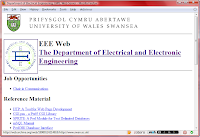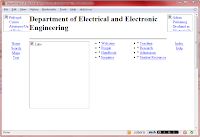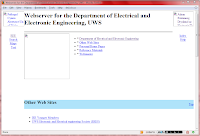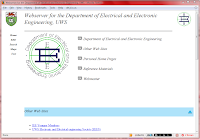One of the highlight’s of yesterday’s History of Computing Collection launch was Steve William’s presentation of the history of the University’s web site which he gathered from the Way Back Machine at the Internet Archive. As I developed the Department of Electrical and Electronic Engineering’s web site from 1996 through to around 2006 I thought I’d visit the Way Back Machine to look at how that web site http://www-ee.swan.ac.uk/ developed. I will probably have to write down the technical details one day, but for now, here are the key development stages:
 In January 1998 the site looked like this. You’ll possibly note that the home page isn’t even about the department! Instead it contains a link to the actual home page.
In January 1998 the site looked like this. You’ll possibly note that the home page isn’t even about the department! Instead it contains a link to the actual home page.  I clearly didn’t know much about Information Architecture then. However to ensure that the site was consistently formatted, I was using a templating tool called HTP (which is still available from sourceforge).
I clearly didn’t know much about Information Architecture then. However to ensure that the site was consistently formatted, I was using a templating tool called HTP (which is still available from sourceforge). In January 1999 the site was formatted to a corporate style using table layout and had a guestbook!
In January 1999 the site was formatted to a corporate style using table layout and had a guestbook!By January 2000 we had style sheets (note that the links turn red
 on hover) and custom bullets. The University’s site at this time was using images of text in order to use the Palatino font that the consultants had decided that its corporate branding needed! I was using Times
on hover) and custom bullets. The University’s site at this time was using images of text in order to use the Palatino font that the consultants had decided that its corporate branding needed! I was using Times  Roman Italic! The three column layout was done with tables.
Roman Italic! The three column layout was done with tables.From 2000 to 2005 the web site design stayed pretty constant. The only thing that changed behind the scenes were that I moved from HTP to the Perl Template Toolkit for the site templating.
 In 2006, the Department finally turned off www-ee.swan.ac.uk and the engineering web site was established. This is run inside the University’s Content Management System (CMS). That site is undergoing a relaunch this summer.
In 2006, the Department finally turned off www-ee.swan.ac.uk and the engineering web site was established. This is run inside the University’s Content Management System (CMS). That site is undergoing a relaunch this summer.
I no longer maintain a large web site, but if I did, I’d use a CMS like Drupal. For small “vanity sites” or group home pages, I’d recommend using a wiki: my homepage these days is a Dokuwiki wiki.
Comments:
AJCann - Feb 5, 2011
Thanks for your valuable input Chris, much appreciated that you chose to share with the wider academic community.
It was my pleasure. Hope to meet you in person one of these days!